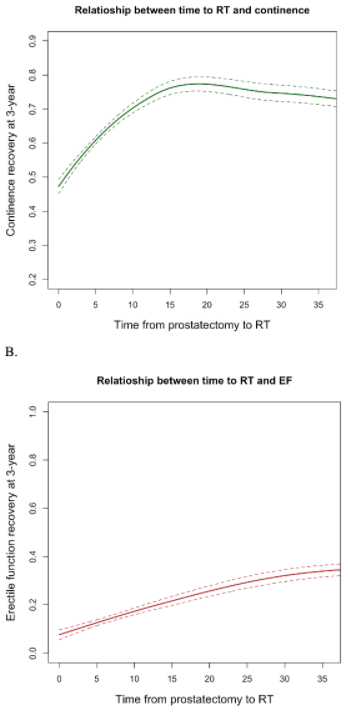Back
Poster, Podium & Video Sessions
Moderated Poster
MP27: Prostate Cancer: Advanced (including Drug Therapy) I
MP27-03: Delaying Post-Operative Radiation Therapy After Radical Prostatectomy Is Associated With Increased Functional Outcomes: Results From A Large Single, Referral Center Series
Saturday, May 14, 2022
10:30 AM – 11:45 AM
Location: Room 222
Mario de Angelis*, Elio Mazzone, Milano, Italy, Giorgio Gandaglia, Armando Stabile, Milan, Italy, Simone Scuderi, Francesco Barletta, Daniele Robesti, Milano, Italy, Luigi Nocera, Milan, Italy, Riccardo Leni, Milano, Italy, Vito Cucchiara, Milan, Italy, Marco Bandini, Milano, Italy, Emanuele Zaffuto, Milan, Italy, Nazareno Suardi, Genoa, Italy, Andrea Necchi, Milano, Italy, Shahrokh F. Shariat, Vienna, Austria, Francesco Montorsi, Alberto Briganti, Milano, Italy
- Md
Poster Presenter(s)
Introduction: Previous studies reported a detrimental effect of postoperative radiotherapy (RT) on functional outcomes in men treated with radical prostatectomy (RP). However, it is still unclear whether an optimal timing to mitigate such detrimental effect may exist. We explored the correlation between time from RP to RT on urinary continence (UC) and erectile function (EF) recovery.
Methods: We evaluated 3,867 men treated with RP between 2000 and 2018 at a single center and stratified for RT schedule (adjuvant RT [aRT], salvage RT [sRT], no RT). We examined EF and UC recovery rates at 3-year according to RT schedule, and according to time from RP to RT. UC recovery was defined as no pad use, while IIEF-EF score =22 defined EF recovery. Multivariable Cox regressions tested predictors of functional outcomes. Covariates consisted of type of approach (robotic vs open), nerve-sparing status, preoperative EF and UC status and year of surgery. The correlation between time from RP to RT and UC and EF recovery rates at 3-yr was explored using the Lowess function.
Results: Overall, 3032 (79%) received no postoperative RT, while 456 (12%) and 336 (9%) men underwent aRT or sRT. Median time to aRT and sRT were 4 and 24 months, respectively. The 3-year EF rates were 35%, 29% and 12% in men who received no RT, sRT and aRT (p <0.001). The 3-year UC rates were 84%, 60% and 70% in patients who received no RT, aRT and sRT (p <0.001). Cox regressions confirmed the negative impact of RT type on UC (aRT OR 0.51 p<0.001; sRT OR 0.71 p=0.009) and EF (aRT OR 0.27 p<0.001; sRT OR 0.58 p<0.001) recovery. At Lowess analysis, UC recovery was lower when men received postoperative RT within 18 months after RP, thereafter a substantial plateau of 3-yr UC was recorded. Similarly, the predicted 3-yr EF recovery rate progressively increased with delayed RT from RP, with rates ranging from 8 to 33% but without reaching a plateau (Fig. 1A-B).
Conclusions: Postoperative RT was strongly associated with lower rates of UC and EF recovery. A variable correlation with time to RT was observed. Particularly, when postoperative RT is planned, UC recovery could be optimized if RT is administered later than 18 months from surgery. Conversely, for EF recovery, a linear correlation with time to RT was observed.
Source of Funding: None.

Methods: We evaluated 3,867 men treated with RP between 2000 and 2018 at a single center and stratified for RT schedule (adjuvant RT [aRT], salvage RT [sRT], no RT). We examined EF and UC recovery rates at 3-year according to RT schedule, and according to time from RP to RT. UC recovery was defined as no pad use, while IIEF-EF score =22 defined EF recovery. Multivariable Cox regressions tested predictors of functional outcomes. Covariates consisted of type of approach (robotic vs open), nerve-sparing status, preoperative EF and UC status and year of surgery. The correlation between time from RP to RT and UC and EF recovery rates at 3-yr was explored using the Lowess function.
Results: Overall, 3032 (79%) received no postoperative RT, while 456 (12%) and 336 (9%) men underwent aRT or sRT. Median time to aRT and sRT were 4 and 24 months, respectively. The 3-year EF rates were 35%, 29% and 12% in men who received no RT, sRT and aRT (p <0.001). The 3-year UC rates were 84%, 60% and 70% in patients who received no RT, aRT and sRT (p <0.001). Cox regressions confirmed the negative impact of RT type on UC (aRT OR 0.51 p<0.001; sRT OR 0.71 p=0.009) and EF (aRT OR 0.27 p<0.001; sRT OR 0.58 p<0.001) recovery. At Lowess analysis, UC recovery was lower when men received postoperative RT within 18 months after RP, thereafter a substantial plateau of 3-yr UC was recorded. Similarly, the predicted 3-yr EF recovery rate progressively increased with delayed RT from RP, with rates ranging from 8 to 33% but without reaching a plateau (Fig. 1A-B).
Conclusions: Postoperative RT was strongly associated with lower rates of UC and EF recovery. A variable correlation with time to RT was observed. Particularly, when postoperative RT is planned, UC recovery could be optimized if RT is administered later than 18 months from surgery. Conversely, for EF recovery, a linear correlation with time to RT was observed.
Source of Funding: None.


.jpg)
.jpg)